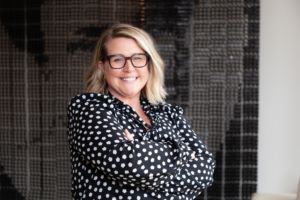
This month, Indy Maven is all about one thing, communication. It’s everything – the primary method that connects us and gives us a way to make our needs and wants known. Whether you need help communicating with your boss or your bestie, read on for seven Indianapolis-area experts’ personal and professional tips on how to be your best communicator.
Want more? Attend our Monthly Meetup on January 12 at 6 pm to hear from three WTHR anchors about what it’s like to be a woman in the media today and learn their best communication practices.
GRETA SNELL, VICE PRESIDENT OF STRATEGIC INITIATIVES, DITTOE PUBLIC RELATIONS

Less is often more (when it comes to word count).
In public relations and strategic communications, we are challenged often to share a lot of information in very few words. From social media copy to media relations to client communications, creative and concise storytelling is truly an art form. Practice delivering more direct, concise communications. Eliminate the fluff where you can without losing the creativity. Yes, it’s as hard as it sounds, but the more you do it, the more natural it becomes.
Personalize and be personable.
We are humans, not machines. While so much of our communication is done from behind a screen – instant messaging, emails, virtual meetings, and more – we must continue to communicate with the understanding that a human is on the other end. Lead with empathy, draw connections, be gracious and give grace, practice patience, and show your personality while maintaining an appropriate amount of professionalism (when applicable, of course). Robotic or automated communication is white noise and adds little to no value to the relationships you are building or the impactful work you are doing. Whether to family, friends, colleagues, clients or otherwise, add a little life to your communications.
Place value on clear, consistent communications with key stakeholders first.
This can apply in both life and business, but your internal stakeholders are the heart of your system. As such, they should always be the first group with whom you communicate. In a personal setting, this may mean your immediate family. In a professional setting, this may mean your employees. In either scenario, making sure the news comes directly from the source opens channels for dialogue, creates a culture of trust, and builds stronger relationships.
NOELLE SNIDER, DIRECTOR OF COMMUNICATIONS, WOMEN4CHANGE INDIANA

Connect with others and exchange ideas.
I never see other organizations as competition but as inspiration. Everyone has their unique backgrounds and experiences that have built them into the professionals they are, and so do you. Connect with others and learn from them as they can learn from you too.
Don’t shy away from feedback.
Your supporters, mentors, and followers are with you for a reason. There are constantly new ways to improve your messaging and branding. Having the humility to make corrections or improve in the future shows your community that you truly are trying to be the best you can be for them.
AISHA ROSE, LIFESTYLE CREATIVE

The key to effective communication is listening for understanding.
Too often, we listen with the intent to respond before we have a clear understanding of what’s truly being shared with us.
Remember when communicating that your experience is valid.
Sometimes we shy away from sharing in relationships or at work because we’re concerned about how it will be received. We fear that we’re going to hurt, upset, or disappoint someone. However, sharing from a place of truth with good intent is the only way that you don’t disappoint yourself in the long run.
Your words have power.
They can impact a situation, relationship, and even a person. Know how to identify within yourself when emotions are too high to effectively choose your words wisely. Hit the pause button and regroup later. Some things you say can’t be taken back, even if followed by an apology.
MELANIE ALLEN, CEO AND CO-FOUNDER, GREEN LOOP MARKETING

Structure and purpose are paramount when having a meeting, otherwise, what’s the point?
Taking a few minutes to prepare a quick agenda prior to a meeting ensures productivity and clear direction for everyone, and it shows you consider others and value their time.
Jumping to conclusions has been a go-to move for me, and I’m actively working on assuming best intentions.
If someone isn’t quick to respond, they may be caught in meetings or drowning in a sea of emails. If someone is snippy with me, it likely isn’t about me. People have so, so much going on every day and we all carry our moods with us. Being positive and understanding goes a long way.
Keeping a hyper-organized email inbox is important to me.
I love to draft an email subject line so it’s easily searchable later on. This helps both me and the folks I’m communicating with reference things quickly as projects progress.
LATEVA WOOLFORK, FOUNDER & CEO, SOCIALLY COORDINATED MARKETING & PR (SOCOPR)

Connection is the key to communication.
Find topics you are passionate about personally and professionally. Use these connection points to engage with your community to build long-standing relationships in your written and digital outlets.
Listen.
Yes, I know that sounds cliche, but ACTIVE LISTENING is the best market research you can do. I want you to know that engaging with what your customer or community needs will elevate your communication skills.
LAUREN CARPENTER, MARKETING & COMMUNICATIONS MANAGER, HVAF

Make sure the person feels safe.
In my professional life, before I start an interview, I always tell the interviewee that if there is a question I ask that they don’t feel comfortable asking – let me know and we can move on to the next question. I carry this into my personal life as well – when talking with a loved one, I am careful with my questions and tell them they don’t have to answer if they don’t want to. Also, I ask myself, “Am I asking because I care or am I just being nosey?” That hurts to answer truthfully but it can help your friendship/relationship so much.
Be sure to be an active listener.
When I am interviewing someone for an article I write, it is so hard for me to not be thinking about the next question in my head. When I do that, I could be missing out on a follow-up question to what they are telling me now – and then missing out on a greater story than I could plan to write.
EMILY LONGNECKER, REPORTER, WTHR

Everybody is somebody, and everybody is nobody.
In my early reporting days, I used to get extremely nervous when I had to interview anyone with an important title and I told my mom about it. She gave me this advice: “Emily, everybody is somebody, and everybody is nobody. No matter what title they have in front of their name. If you remember that, you’ll always be respectful and know how to treat people.”
Give the benefit of the doubt.
I think it’s important to approach a conversation by giving folks the benefit of the doubt and assuming they are approaching you with a spirit of goodwill. I try to always be kind with my tone because you never know what kind of day someone is having or what’s going on in their lives.
Also though…if someone crosses a boundary in their communications with you, you have to be ready to check them. I find I have to do this sometimes when someone is trying to tell me that I’m not allowed to be somewhere, I know as a member of the media, I most certainly am allowed. I’m polite but firm.
Our stories matter.
When I do an interview and someone is nervous to talk to me, I always tell them, “Let’s just have a conversation. Talk to me about what you know. Take me into the heart of the matter.”
At the end of the day, everyone has a story to tell. Everyone. People want to know they matter, that their story matters and they want someone to listen to them. They want to spend time with someone with whom they can connect.
Admit what you don’t know.
In this line of work, you have to be willing to admit you don’t understand something, a topic, or a concept. You have to be able to approach someone with humility and ask, “Help me understand what’s going on here.” I find if you’re honest about your shortcomings or can admit where you have a gap in knowledge, it goes a long way.
Chrissy Bruns is an Indy Maven contributor.
All of our content—including this article—is completely free. However, we’d love if you would please consider supporting our journalism with an Indy Maven membership.













